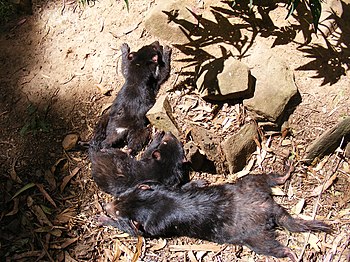 |
| Three young Tasmanian Devils. (Photo credit: Wikipedia) |
Richard Conniff is the author of The Species Seekers: Heroes, Fools, and the Mad Pursuit of Life on Earth and other books. full bio.
Midway through the new special issue of Science, about the global loss of wildlife, my heart caught on this idea: we now live with a steady, imperceptible loss “in people’s expectations of what the natural world around them should look like,” and “each generation grows up within a slightly more impoverished natural biodiversity.”
It’s not just about elephants, rhinos, and other iconic species disappearing. It’s about the decline of everything.
When children go outdoors today - to the extent that they go outdoors at all - they see 35% fewer individual butterflies and moths than their parents would have seen 40 years ago, and 28% fewer individual vertebrates - meaning birds, mammals, amphibians, reptiles, and fish.
It’s not quite a silent spring, just one that is becoming quieter with each passing year, insidiously, so we hardly notice. The Science authors dub this phenomenon “defaunation.” I prefer to think of it as “the great vanishing,” but either way it’s bad news.
Why don’t we do something about it? Wildlife conservation suffers under a misguided notion that it is a boutique issue.
“Animals do matter to people,” according to one article in the Science special issue, “but on balance, they matter less than food, jobs, energy, money, and development. As long as we continue to view animals in ecosystems as irrelevant to these basic demands, animals will lose.”
That need not be as hopeless as it sounds, because the authors go on to remind us in alarming detail just how utterly our economic and political well-being depend on keeping wildlife populations healthy.
Insect pollinator populations, for instance, are now in free-fall. But they are essential for 75% of the world’s food crops. Somewhat less obviously, native predators - mainly insects, birds, and bats - also provide natural pest control, worth an estimated $4.5 billion annually in the United States.
Half our pharmaceuticals come from the natural world, many of them from wildlife. The fer-de-lance snake, for instance, gave us ACE inhibitors, our most effective medicine for heart disease. A deadly cone snail gave us a painkiller, called Prialt, that’s more potent than morphine and yet not addictive.
Much more directly, a billion of the world’s poorest people also depend on wildlife as their main source of animal protein, and 2.6 billion rely on seafood protein. Failure to manage these resources so they will be available next year, and the year after, is a recipe for starvation, civil unrest, terrorism, and the collapse of economies, if not of civilization itself.
We may roll our eyes about ethical shoppers armed with their Monterey Bay Aquarium sustainable seafood guidelines. But illegal and unmanaged fisheries are anything but a niche issue.
On the contrary, when a weak government allowed foreign vessels to decimate the fisheries on the coast of Somalia, it turned former fishermen into pirates. That scenario is now being replayed in the West African nations of Benin, Senegal, and Nigeria.
In Thailand, failure to manage the fisheries now forces boats to “travel farther, endure harsher conditions, search deeper, and fish for longer to obtain the types of harvests more readily available a generation ago,” according to the Science writers.
Men - and children - who are essentially slaves “may remain at sea for several years without pay, forced to work 18- or 20-hour days. Starvation, physical abuse, and murder are common on these vessels.”
The Science authors outline some of the steps we can take to stop or even reverse this catastrophic pattern of decline.
They say President Obama’s interagency task force on wildlife trafficking and the European and Asian “war on poachers” aren’t enough. That approach takes on crime and terrorism funded by wildlife trafficking, but it misses the basic conservation ecology.
Among better solutions, the Science authors say, we should advocate giving fishermen and hunters exclusive rights to harvest grounds, so they will become invested in protecting long-term productivity. That’s worked with fisheries in Fiji and with community conservancies covering almost half the land area in the southeast African nation of Namibia.
The authors also propose more radical forms of species translocations. Conservationists in Australia and Asia have introduced populations of the kakapo, or owl parrot, to remote islands, to protect them from introduced mammalian predators on the mainland.
Likewise, a population of disease-free Tasmanian devils is living outside its native range. In some cases where important species have gone extinct, it may help to introduce a substitute species that performs a similar ecological function.
Aldabra giant tortoises, for instance, have now replaced an extinct Mauritian tortoise to restore grazing functions and seed dispersal of native large-seeded plants on that island.
Finally, the authors argue for “a new model of coexistence between predators and humans over large spatial scales,” and they cite as a model the recovery, in densely populated Europe, of golden jackals, gray wolves, Eurasian lynx, Iberian lynx, and wolverines.
One hitch may be that we don’t know which species we depend on, and we may not even recognize when some nematode, or beetle, or bat that is functionally more important than, say, the rhino, is disappearing.
Reading this special issue, I keep thinking of prochlorococcus, an ocean microbe, which wasn’t even discovered by scientists until the 1980s. It produces 20 percent of the oxygen we breathe - one of every five breaths.
That suggests why the authors believe that “the cryptic nature of defaunation has strong potential to soon become very non-cryptic, rivaling the impact of many other forms of global change” - think earthquakes, volcanic eruptions, tsunamis, even meteorites crashing down from space - “in terms of loss of ecosystem services essential for human well-being.”
In other words, it’s not just about saving wildlife. It’s about saving our world. It’s about saving ourselves.
No comments:
Post a Comment